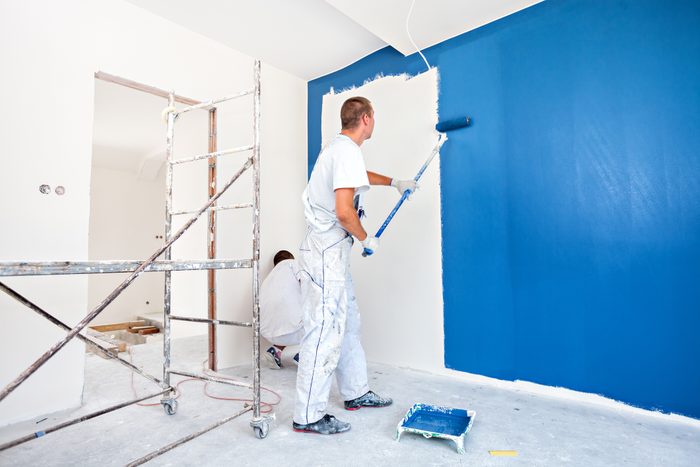How To Conduct the Paint Inspection When You Hire a Pro

Before the first can of paint is opened and the last dropcloth is back in the van, be a savvy homeowner with these paint inspection best practices.
I can paint just as well, and probably better, than any crew I could hire. I’ve done a lot of painting and a hired painter won’t be as persnickety about the details as I am. Or so I think.
Recently, I was busy and hired a crew to paint my kitchen. I learned two things about inspecting a paint job:
- Consideration. There are other good painters in the world beside me. Really. They have their own ways of doing things that help them be professionals. “I’ve done a lot of painting, too,” says Vince Christofora, owner of Woodstock Hardware in Woodstock, New York. “I might tape off trim, but pros may not and expertly cut in the paint with a much better brush than I might use.”
- Communication. Sometimes, I bite my tongue and lived with the pro’s painting approach. Other times, a detailed contract of the project (prep to clean up) was my ally. When something was not done, I could respectfully but confidently refer to the contract and not worry about nagging or micromanaging. “Nobody likes being confrontational,” says Christofora. “Pull out the contract when X, Y and Z are not done.”
On This Page
When to Inspect the Paint Job
Inspect with each step, not when the project is complete. “You have most leverage before final payment,” says Christofora. “Intermediate inspections help everyone. No painter wants to break down ladders or scaffolding only to learn the customer has a small issue two stories up that could have been easily addressed when the scaffolding was still in place,” he explains.
Christofora recalls this anecdote from when he built and opened a laundromat in December. “Come April when we tried to open windows, all were painted shut with two coats. When we called the painter, he freaked out and denied doing it. After logically walking through the facts, he agreed he must have done it and carefully cut the paint so the windows worked. But, the back and forth soured our relationship, and we never called this painter back.”
If possible, inspect in the morning not at day’s end when painters are bushed. “Asking a question is better than telling them they did something wrong,” adds Christofora. During an inspection, be fair and stick to the contract. “Trying to get extras while holding up payment is sure to create a sour relationship.”
Helpful Inspection Tools
- Flashlight or battery-powered work light.
- Painter’s tape or sticky notes to mark spots requiring attention. Do not use tape that when removed might damage painted surfaces.
- Cell phone or digital camera to document locations requiring attention.
- Step stool, small ladder or an extendable inspection mirror to see tops of doors or shelving.
What to Look for When Inspecting an Interior Paint Job
This applies to walls, ceilings, trim and cabinets:
- No drips, runs, dents, holes or marks on walls.
- All cut-in lines around trim and at changes in color between walls and ceiling should be straight and crisp.
- No paint spots on unpainted paneling, trim, light and outlet covers, heating ducts and registers.
- Joints where window, door and baseboard trim meet walls should be caulked before painting. Caulk should not be applied to cover up a bad paint job. Caulk discolors over time.
- Nail holes in window and door trim and baseboards should be filled and painted.
- Check window glass for paint splatter. The painter should be responsible for removing paint and, if in the contract, for window cleaning after painting.
- All doors, including closet doors, should be painted on all sides. Painting tops and bottoms prevents moisture from entering the door, which avoids swelling and opening and closing problems.
- If windows and doors, or trim around them, are painted, make sure they operate properly and weather stripping was not damaged.
- Inside of closets should have two coats of paint. Closet poles, brackets and shelving should be paint free.
Tip: Have the painter leave touch-up paint. The paint can should include brand name, color name and sheen. Paint the back of a switch plate cover in each room with the room paint, and write the information there, as well.
What To Look for When Inspecting an Exterior Paint Job
According to Christofora, exterior inspection is much the same as interior, with the addition of:
- Make sure landscaping and plantings are covered and protected. Tie back or prune plantings close to the foundation where ladders or scaffolding may be placed.
- Wet down grass or plants coming in contact with cleaning solutions before the cleaning, and rinse afterward. This minimizes plant burning or damage.
- Check decks, patios, sidewalks, driveways, roofs and chimneys for paint spills and drips.
- Make sure the top, bottom and both edges of each panel of overhead garage doors are painted.
What to Do If You Find a Problem Later
After final inspection, there should be little cause for return. “With the rare coating failure,” says Christofora, “painters may be called back. Usually, a failure is because the surface was not prepared properly or directions were not followed pertaining to weather conditions, etc. These callbacks are problematic because painters either did not do the work right or the customer demanded a cold weather painting, for example, and the painter relented, causing the paint to not perform as intended.”
Tip: A new addition or home can “settle,” creating cracks in ceiling joints or “popped” drywall screws over the course of 12 to 18 months. Repairing these is usually the homeowner’s responsibility.



